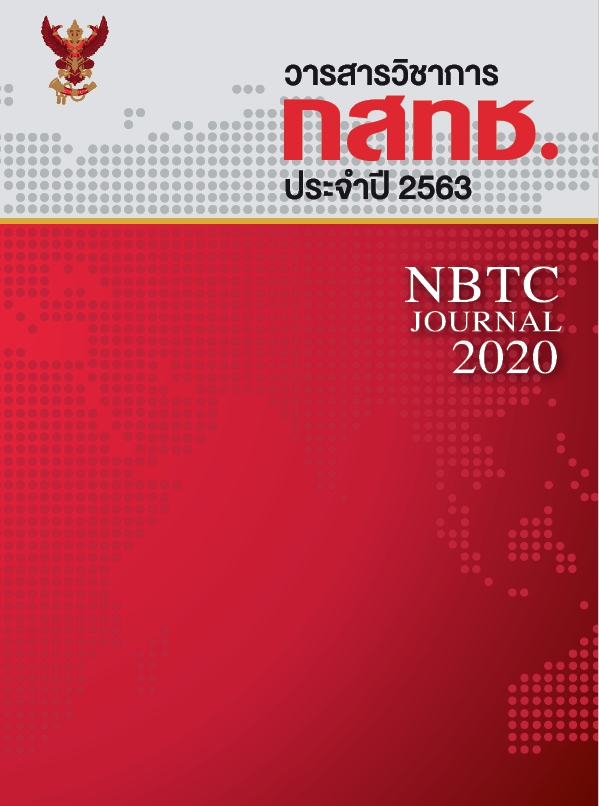Parents’ sharenting and the value of child privacy in social media
Keywords:
Parents’ sharenting, information privacy, child privacy, child value, social mediaAbstract
The application of social media among modern parents for surveilling their children’s activities have rapidly increased in recent Thai society which, in turn, affect child information privacy. Children are the vulnerable group which their privacy can be violated by their parents’ sharenting some of their pictures or video-clips on social media. This article aims to present the problem of parents’ sharenting and the value of child privacy in the context of social media. The study was a documentary research conducted by literature review and content analysis of the problem of parents’ sharenting and the value of child privacy in social media. The results found that child privacy is the personal rights as well as valuable for itself. Child privacy protection affects personal data disclosure which build both child’s physical and mental stabilities. In addition, Child privacy protection is a crucial key for identity development and strengthen social relationship. To sum up, child privacy in social media is an essentiality and valuable to be protected for all children.
References
คณาธิป ทองรวีวงศ์. (2559). การปฏิรูปกฎหมายคุ้มครองข้อมูลส่วนบุคคลของไทยเพื่อเข้าสู่ประชาคมอาเซียน, รายงานการวิจัย.
ค้นเมื่อ 30 พฤษภาคม 2563 จาก https://library2.parliament.go.th/ebook/content-er/2560-kanathip.pdf
เครือข่ายพลเมืองเน็ต. (2559). การละเมิดความเป็นส่วนตัวออนไลน์ในสังคมไทย พ.ศ. 2556. ค้นเมื่อ 27 พฤษภาคม 2563 จาก http://www2.it.kmutnb.ac.th/teacher/FileDL/AsstProfDrNattavee175255914470.pdf
ณิชากร ศรีเพชรดี และทิพย์พิมล เกียรติวาทีรัตนะ. (2561). ทำความเข้าใจร่วมกัน โพสต์รูปลูกลงโซเชียลแค่ไหนจึง ‘ปลอดภัย’ ไม่ทำร้ายเด็ก. The Potential. ค้นเมื่อ 29 พฤษภาคม 2563 จาก https://thepotential.org/2018/
/22/sharenting/.
ไทยรัฐ. (2559). พ่อแม่ยิ่งต้องรู้ สิทธิเด็กโลกออนไลน์. ค้นเมื่อ 26 พฤษภาคม 2563 จาก http://www.thairath.co.th/content/785621
ผู้จัดการออนไลน์. (2563). ถนนสู่ดวงดาว : ความเสี่ยงบนโลกออนไลน์ที่พ่อแม่หยิบยื่นให้ลูก. ค้นเมื่อ 13 มิถุนายน 2563 จาก
https://mgronline.com/cyberbiz/detail/9630000055072
พริบพันดาว. (2559). สิทธิเด็กในภาพถ่ายและการเคลื่อนไหว. ค้นเมื่อ 13 มิถุนายน 2563 จาก http://www.posttoday.com/life/life/448783
พันธ์ศักดิ์ อาภาขจร. (2559) ความจริงของโลกออนไลน์ : ความจริงที่ภาครัฐต้องใส่ใจ. สำนักข่าวอิสรา. ค้นเมื่อ 13 มิถุนายน 2563
จาก https://www.isranews.org/isranews/49987-a_49987.html
โพสต์ทูเดย์. (2559). ภาพของลูกบนสังคมออนไลน์. ค้นเมื่อ 13 มิถุนายน 2563 จาก http://www.posttoday.com/newspaper/magazine/431926
ระวิ แก้วสุกใสและชัยรัตน์ จุสปาโล. (2556). เครือข่ายสังคมออนไลน์ : กรณี เฟสบุ๊ค (Facebook) กับการพัฒนาผู้เรียน.
วารสารมหาวิทยาลัยนราธิวาสราชนครินทร์, 5 (ฉบับพิเศษประจำปี 2556), 195-205.
วริษฐา แซ่เจีย. (2019). Cyberstalking : การสอดแนมบนโลกออนไลน์ กับนโยบายความเป็นส่วนตัว. The Matter.
ค้นเมื่อ 20 มิถุนายน 2563 จาก https://thematter.co/social/cyberstalking-and-privacy-policy/87747
สุรินทร์ แก้วทอง. (2562). กฎหมายคุ้มครองข้อมูลส่วนบุคคลของเด็กและเยาวชน. กรุงเทพธุรกิจ. ค้นเมื่อ 30 พฤษภาคม 2563
จาก https://www.bangkokbiznews.com/blog/detail/647319
สำนักงานพัฒนาธุรกรรมทางอิเล็กทรอนิกส์ (องค์การมหาชน). (2563). เอกสารการแถลงผลการสำรวจพฤติกรรมผู้ใช้อินเทอร์เน็ตในประเทศไทย ปี 2562 (Thailand Internet User Behavior 2019) วันที่ 30 มีนาคม 2563. ค้นเมื่อ 23 มิถุนายน 2563
จาก https://www.etda.or.th/publishing-detail/thailand-internet-user-behavior-2019-slides.html
สำนักงานสถิติแห่งชาติ. (2561) การสำรวจการมีการใช้เทคโนโลยีสารสนเทศและการสื่อสารในครัวเรือน พ.ศ.2561. ค้นเมื่อ 23 มิถุนายน 2563 จาก : http://www.nso.go.th/sites/2014/DocLib13/ด้านICT/เทคโนโลยีในครัวเรือน/2561/ict61-CompleteReport-Q1.pdf
Boyd, D.M. and Ellison, N.B. (2008). Social Network Sites: Definition, History, and Scholarship. Journal of
Computer-Mediated Communication, (13), 210–230. Retrieved June 3, 2020 from http://onlinelibrary.wiley.com/doi/10.1111/j.1083-6101.2007.00393.x/full
Castells, M. (2010). The Rise of the Network Society. 2nd eds. Oxford: Blackwell Publishing.
iLaw. (2561). “ความเป็นส่วนตัวอย่าเพิ่งตาย” เมื่อโลกหมุนไปไกล กฎหมายไทยต้องรีบมา ค้นเมื่อ 23 มิถุนายน 2563
จาก https://ilaw.or.th/node/4908
Kozinets, R. V. (2010). Netnography : Doing Ethnographic Researh Online. London: SAGE Publication Ltd.
Lupton, D. (2016). The use and value of digital media for information about pregnancy and Early motherhood: a focus group study. BMC Pregnancy and Childbirth. 16(171), 1-10.
Lupton, D, Pedersen, S and GM. Thomas. (2016). Parenting and Digital Media: From the Early Web to Contemporary Digital Society. Sociology Compass. 10(8), 730-743.
Mclaughlin, E. and Muncie, J. (2006). The Sage Dictionary of Criminology. London: Sage Publications Ltd.
Miller, Daniel และคณะ. (2562). Why We Post: ส่องวัฒนธรรมโซเชียลมีเดียผ่านมานุษยวิทยาดิจิทัล. แปลจาก How the World Changed Social Media. แปลโดย ฐณฐ จินดานนท์. กรุงเทพฯ : บุ๊คสเคป.
Positioning. (2559). เจาะ 6 พฤติกรรม “คุณแม่ Gen M” ค้นเมื่อ 13 มิถุนายน 2563 จาก : https://positioningmag.com/1102677
Shmueli, B. and Blecher-Prigat, A. (2011). Privacy for Children. Columbia Human Rights Law Review, 42, 759-95.
Steinberg, S.B. (2017). Sharenting: Children’s Privacy in the Age of Social Media. Emory Law Journal, 66, 839-884.
The Bangkok insight editorial team. (2563). หมอเล่าไทม์ไลน์สงสัย “แม่ปุ๊ก” ทำร้ายอมยิ้ม-อิ่มบุญ. ค้นเมื่อ 13 มิถุนายน 2563 จาก https://www.thebangkokinsight.com/366226/
Theprototype. (2561). ผลวิจัยพบว่า “สื่อสังคมออนไลน์ละเมิดสิทธิเด็ก!!!” ค้นเมื่อ 13 มิถุนายน 2563 จาก https://theprototype.pim.ac.th/2018/06/12/crc/
Walther,J.B. (2011). Introduction to Privacy Online in S.Trepte and L.Reinecke (eds.), Privacy Online : Perspectives on Privacy and Self-Disclosure in the Social Web, pp. 3-7. New York : Springer-Verlag.
Downloads
Published
How to Cite
Issue
Section
License
The Office of the NBTC holds the copyright of articles appearing in the journal. The Office of the NBTC allows the public or individuals to distribute, copy, or republish the work under a Creative Commons license (CC), with attribution (BY), No Derivatives (ND) and NonCommercial (NC); unless written permission is received from the Office of the NBTC.
Text, tables, and figures that appear in articles accepted for publication in this journal are personal opinion and responsibility of the author, and not binding on the NBTC and the Office of the NBTC. In case of errors, each author is solely responsible for their own article, and not concerning the NBTC and the NBTC Office in any way.



